The RMS Lusitania, or “The Lucy” as she was affectionately known, was launched on Thursday, 7 June 1906, at the shipyard of John Brown & Co., Clydebank. She was built as a result of negotiations between the British Government and Cunard Line to build two superliners capable of taking back the Blue Riband for the fastest Atlantic crossing. At her launch she was described by Charles McLaren, Chairman of John Brown, as “the largest vessel ever to have put into the water… whilst her engine power would be such as to send her across the Atlantic at a speed never yet accomplished, except by a torpedo boat destroyer”. She was the first British passenger ship to be built with four funnels, with a gross tonnage of 32,500 tons and overall length of 785 ft, and with seven decks for the use of passengers. On Saturday, 7 September 1907, after the completion of her trials, she sailed from Liverpool on her maiden voyage to Queenstown and New York, watched by a crowd of 200,000 spectators.”
– Merseyside Maritime Museum Archives
Buenos Aires – Dining aboard an ocean liner was, and sometimes still is, a very elegant affair. These days, perhaps too many of them offer up all you can eat buffets, many stocked with mediocre food, but there was a time when the dining was truly a wonderous affair – with ornate printed menus and classic French service – and a cuisine that was “haute Continental” – the only continent of note, at the time, being Europe. Being the 100th anniversary of the launch of the RMS Lusitania, it seemed worthy of looking at some of the cuisine that they offered up. It took a little digging… well, not really that much, a google image search, to come up with a couple of photos of some of those early menus, and pulling ideas off of them, where I was able to read them clearly enough, turned out to provide more than enough inspiration for our Casa S dinner this weekend.
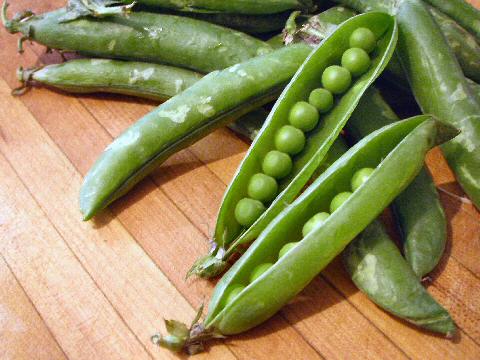
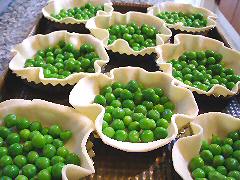 The timing proved fortuitous, as just this last week, fresh peas in the pod started appearing on the local vegetable stands. I grabbed a couple of kilos of them and set to work shelling peas – something I don’t think I’ve done since I was a kid. It was actually kind of fun, and I really liked knowing, and being able to see, just how fresh these were. The usual styrofoam packed shelled peas that I see around here are often a little on the hard side, need a lot of time cooking, and have probably been sitting around for way too long. Aren’t these just, well… mouthwatering looking?
The timing proved fortuitous, as just this last week, fresh peas in the pod started appearing on the local vegetable stands. I grabbed a couple of kilos of them and set to work shelling peas – something I don’t think I’ve done since I was a kid. It was actually kind of fun, and I really liked knowing, and being able to see, just how fresh these were. The usual styrofoam packed shelled peas that I see around here are often a little on the hard side, need a lot of time cooking, and have probably been sitting around for way too long. Aren’t these just, well… mouthwatering looking?
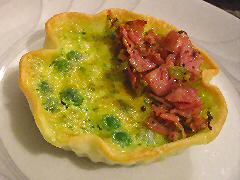 The filling was simple – I blanched and shocked the peas to set their color, which also proved to be enough time to have cooked them ready to eat – and I scooped a few up for myself to nibble on while I worked. The rest of the filling, a mix of cream, eggs, and lots of parsley, pureed together and seasoned with salt and white pepper. The topping on the one half is a lightly crispy mix of sauteed ham and leeks, flavors that go incredibly well with fresh peas. On our second night of the dinners, I made lots of extras… we wanted some for ourselves!
The filling was simple – I blanched and shocked the peas to set their color, which also proved to be enough time to have cooked them ready to eat – and I scooped a few up for myself to nibble on while I worked. The rest of the filling, a mix of cream, eggs, and lots of parsley, pureed together and seasoned with salt and white pepper. The topping on the one half is a lightly crispy mix of sauteed ham and leeks, flavors that go incredibly well with fresh peas. On our second night of the dinners, I made lots of extras… we wanted some for ourselves!
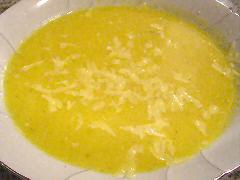 While I have no idea exactly what recipes the chefs on the Lusitania used, it’s not hard to go back and look at classic recipes from the era and use them as inspiration. This soup is a simple one of artichokes – I started off by cooking a coarsely chopped mirepoix – carrots, onions, celery – along with a little garlic, and then added in chopped artichoke hearts (jarred are fine, just soak them in a little fresh water to remove some of the tartness of the liquid they’re packed in, which is usually laced with citric acid). I cooked them until the vegetables were soft, but not browned, then added diced potato, some marjoram, and a good amount of dry vermouth, letting that absorb into the vegetables, then topped it all up with good chicken stock, brought it up to a boil, and let it simmer for awhile. Then I pureed it roughly with a hand blender, seasoned it with salt and white pepper, and served it up with a little grated reggianito cheese over the top.
While I have no idea exactly what recipes the chefs on the Lusitania used, it’s not hard to go back and look at classic recipes from the era and use them as inspiration. This soup is a simple one of artichokes – I started off by cooking a coarsely chopped mirepoix – carrots, onions, celery – along with a little garlic, and then added in chopped artichoke hearts (jarred are fine, just soak them in a little fresh water to remove some of the tartness of the liquid they’re packed in, which is usually laced with citric acid). I cooked them until the vegetables were soft, but not browned, then added diced potato, some marjoram, and a good amount of dry vermouth, letting that absorb into the vegetables, then topped it all up with good chicken stock, brought it up to a boil, and let it simmer for awhile. Then I pureed it roughly with a hand blender, seasoned it with salt and white pepper, and served it up with a little grated reggianito cheese over the top.
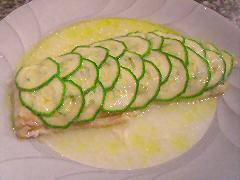 Didn’t this come out pretty? It’s a simple supreme, or fillet of sole, that I placed inside a foil packet with some butter below and above, chopped shallots, and then laid out very thin slices of zucchini in an overlapping scale pattern. A splash of white wine and some salt, sealed the packets, and then baked them in the oven to let the fish steam in its own juices, the wine and butter. It’s a very simple dish, but very elegant to serve, and really tasty – the delicate flavor of the fish is enhanced by the sauce rather than masked, which is what I really wanted to emphasize.
Didn’t this come out pretty? It’s a simple supreme, or fillet of sole, that I placed inside a foil packet with some butter below and above, chopped shallots, and then laid out very thin slices of zucchini in an overlapping scale pattern. A splash of white wine and some salt, sealed the packets, and then baked them in the oven to let the fish steam in its own juices, the wine and butter. It’s a very simple dish, but very elegant to serve, and really tasty – the delicate flavor of the fish is enhanced by the sauce rather than masked, which is what I really wanted to emphasize.
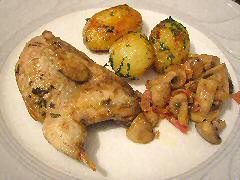 How could I not offer up a roast partridge, especially when it was featured on both menus that I tracked down. I wonder just how many partridges had to be stocked on an ocean liner with nearly 2,000 passengers, with a six-day crossing of the Atlantic in the offing? They’ve gotten pricey here since the last time I cooked up partridges, doubling in cost in less than a year – though perhaps it’s more of a seasonal thing, since being early spring this probably isn’t their main season. This time I halved them, marinated them in juniper and thyme, and then pan roasted them to just a shade past medium – they’d gotten a bit dried out the last time with longer cooking. I served them up with a saute of bacon and button mushrooms, and chateau potatoes, which seemed to be quite popular in that era – I’d actually never made them before, but trust me, I will again – these are delicious! Peel the potatoes and cut them into sections – depending on the size of the potato you’ll get 2-4 pieces probably – and then roughly shape them into “olive shapes” is the classic – mine are a little less formed than the tradition probably calls for, more of a general ovoid… roughly one-inch across and maybe an inch and a half in length. In a big saute pan, put a 50:50 mix of olive oil and butter in – a good amount of each, get it nice and hot, and then add the potatoes. Stir to coat, and regularly keep stirring, while cooking over fairly high heat. I kept the pan covered other than when stirring for about the first 8-9 minutes, just to help cook the potatoes through a little quicker, then removed the cover and kept cooking – the idea being to have them cooked through, and nice and brown and slightly crispy on the outside. At the last moment, toss in lots of chopped parsley (I used the curly type, I like the fresh flavor), and load them up on the plate.
How could I not offer up a roast partridge, especially when it was featured on both menus that I tracked down. I wonder just how many partridges had to be stocked on an ocean liner with nearly 2,000 passengers, with a six-day crossing of the Atlantic in the offing? They’ve gotten pricey here since the last time I cooked up partridges, doubling in cost in less than a year – though perhaps it’s more of a seasonal thing, since being early spring this probably isn’t their main season. This time I halved them, marinated them in juniper and thyme, and then pan roasted them to just a shade past medium – they’d gotten a bit dried out the last time with longer cooking. I served them up with a saute of bacon and button mushrooms, and chateau potatoes, which seemed to be quite popular in that era – I’d actually never made them before, but trust me, I will again – these are delicious! Peel the potatoes and cut them into sections – depending on the size of the potato you’ll get 2-4 pieces probably – and then roughly shape them into “olive shapes” is the classic – mine are a little less formed than the tradition probably calls for, more of a general ovoid… roughly one-inch across and maybe an inch and a half in length. In a big saute pan, put a 50:50 mix of olive oil and butter in – a good amount of each, get it nice and hot, and then add the potatoes. Stir to coat, and regularly keep stirring, while cooking over fairly high heat. I kept the pan covered other than when stirring for about the first 8-9 minutes, just to help cook the potatoes through a little quicker, then removed the cover and kept cooking – the idea being to have them cooked through, and nice and brown and slightly crispy on the outside. At the last moment, toss in lots of chopped parsley (I used the curly type, I like the fresh flavor), and load them up on the plate.
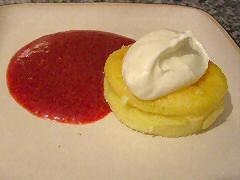 Saxon Pudding anyone? I didn’t even have an idea of what one was, but it sounded intriguing. It’s kind of a heavy souffle of sorts – it doesn’t collapse quite as much as a souffle does when you let it cool, but it’s in the same family – I don’t know, maybe traditionally they’re served right out of the oven still in their ramekins, but I don’t think so – all the recipes I found made a point of removing them, which you could never do with a souffle, and is impossible to do while still hot. For a dozen of these, I creamed together 6 ounces of butter, 6 ounces confectioner’s sugar, 6 ounces of flour (sift the two dry ingredients, please). Then I added in a cup of boiling milk, combined them well, and returned them to the pot over medium heat, stirring continuously, until it forms a sort of loose dough that pulls away from the sides of the pan – it’ll be really obvious, and only takes a few minutes. Remove from the heat, add in 7 egg yolks and combine well. Beat the 7 egg whites until very stiff, and then fold the two mixtures together. Scoop into buttered ramekins – I ended up with about a half cup of mixture for each, and bake in a 350°F oven until puffed and browned. As mentioned, they’ll collapse when they cool. Remove them from the molds, and plate with fresh, sweetened whipped cream, and a roasted strawberry sauce – roast a bunch of strawberries in the oven until all soft and mushy, then puree with a little lemon juice, some maple syrup (or other sweetener or sugar), and a splash of red wine to taste.
Saxon Pudding anyone? I didn’t even have an idea of what one was, but it sounded intriguing. It’s kind of a heavy souffle of sorts – it doesn’t collapse quite as much as a souffle does when you let it cool, but it’s in the same family – I don’t know, maybe traditionally they’re served right out of the oven still in their ramekins, but I don’t think so – all the recipes I found made a point of removing them, which you could never do with a souffle, and is impossible to do while still hot. For a dozen of these, I creamed together 6 ounces of butter, 6 ounces confectioner’s sugar, 6 ounces of flour (sift the two dry ingredients, please). Then I added in a cup of boiling milk, combined them well, and returned them to the pot over medium heat, stirring continuously, until it forms a sort of loose dough that pulls away from the sides of the pan – it’ll be really obvious, and only takes a few minutes. Remove from the heat, add in 7 egg yolks and combine well. Beat the 7 egg whites until very stiff, and then fold the two mixtures together. Scoop into buttered ramekins – I ended up with about a half cup of mixture for each, and bake in a 350°F oven until puffed and browned. As mentioned, they’ll collapse when they cool. Remove them from the molds, and plate with fresh, sweetened whipped cream, and a roasted strawberry sauce – roast a bunch of strawberries in the oven until all soft and mushy, then puree with a little lemon juice, some maple syrup (or other sweetener or sugar), and a splash of red wine to taste.
How yummy…. You just jolted a food memory out of me. I used to make an orange roughy like that except it was with butter, zucchini, and lemon slices. It was very easy, very quick and so good. An old friend of mine amazed me with it when we got to her place and she asked if I would stay for dinner and she was in and out of the kitchen in like no-time. I watched her do it and it was the fastest dinner anyone has ever made for me. We paired it with a very nice chardonnay and I have never forgotten how to make that dish.
Do you do your own food photography? The peas are gorgeous, I found myself wanting to eat them, and I don’t really like eating peas!
I do – though I think the pea picture is more luck than anything else…
[…] more to the dinner than this dessert – we offered up a beautiful fresh green pea soup from just shelled peas, some delightful slightly crocante sweetbreads atop honey spiced yams and fennel, and a different […]